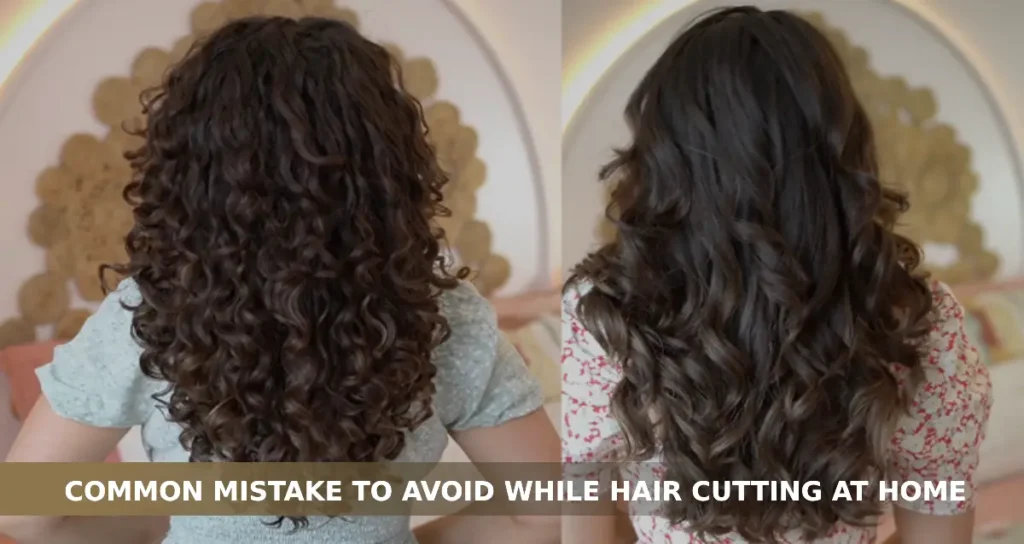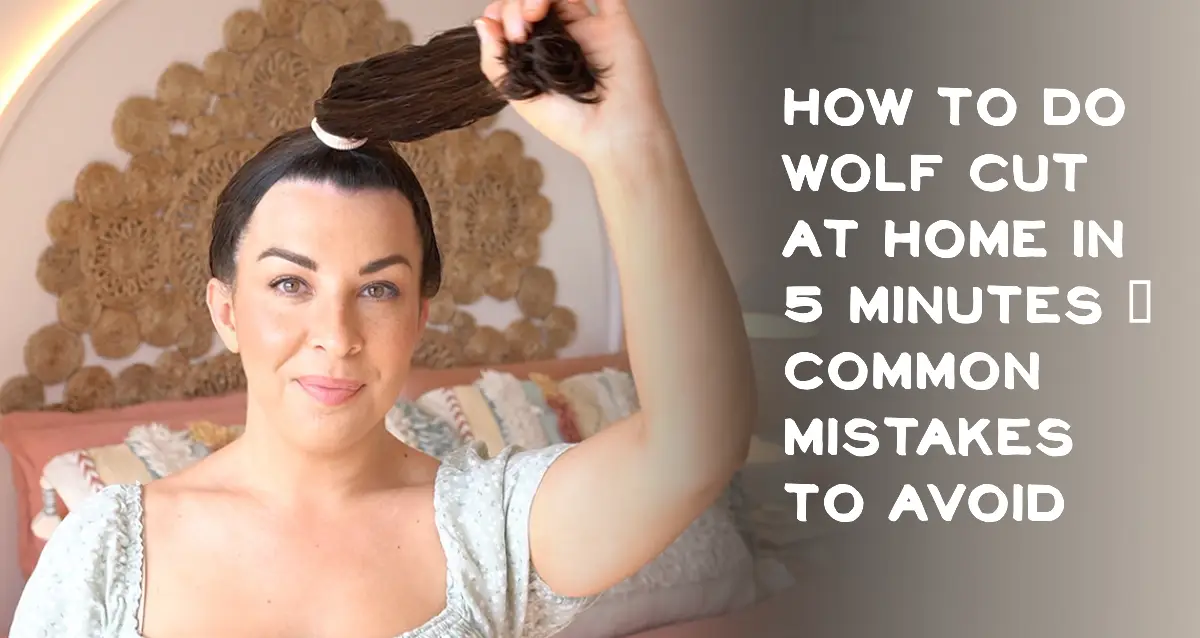How To Do Wolf Cut At Home? Step By Step Guide
The wolf cut, a hybrid of shaggy layers and a mullet’s boldness, has become a global hair trend. Its appeal lies in its edgy yet effortless aesthetic. While salon visits are the traditional route, this guide empowers you to achieve a stylish wolf cut at home, saving time and money.
We’ll cover the necessary tools, preparation steps, a detailed cutting process for both men and women, quick styling tips, and common mistakes to avoid. This guide aims to equip you with the knowledge and confidence to create a professional-looking wolf cut in the comfort of your own home, regardless of your hair type or length. Embrace the freedom of DIY and unleash your inner stylist.
Tools and Materials Needed
Before diving into the haircut process, gathering the right tools is essential. You don’t need professional salon equipment—just a few simple items will do:
- Scissors or Razor Comb – Use sharp hair-cutting scissors for precision or a razor comb for softer, feathered layers. Avoid using dull or household scissors, as they can cause split ends and an uneven cut.
- Comb – A fine-tooth comb helps with sectioning, while a wide-tooth comb can detangle without pulling.
- Hair Clips – Use sturdy clips to hold sections of hair in place for better control while cutting.
- Spray Bottle (Optional) – Slightly dampening your hair can make it easier to cut evenly, but it’s best to avoid soaking wet hair, as it may shrink when dry.
This technique works for both men and women, making it an accessible and gender-neutral way to achieve a stylish wolf cut at home. Whether you have long or short hair, these steps will help you get a layered, textured look without the hassle of visiting a salon.
Preparing Your Hair Before Getting the Wolf Cut at Home
Preparation is key to ensuring your DIY wolf cut turns out great. Follow these steps for a smooth process:
Step 1: Wash and Lightly Towel-Dry Your Hair
Start with clean hair to make cutting easier and more precise. Wash your hair with shampoo and conditioner, then gently towel-dry it so that it’s slightly damp but not dripping wet. This helps prevent frizz and allows for a more controlled cut.
Step 2: Comb Through to Remove Tangles and Section Your Hair
Use a wide-tooth comb to remove any knots and tangles. Then, divide your hair into sections for easier cutting. Typically, you’ll want to:
- Create a top section (this will add volume and layers).
- Separate the sides to maintain balance.
- Leave the back section for cutting in gradual layers.
Tip:
“Preparation is key for a smooth, professional-looking wolf cut!” Taking the time to detangle, section, and slightly dampen your hair will make the cutting process much easier and help you achieve a salon-quality look at home.
Step By Step Guide To Take The Wolf Cut At Home
Let’s get into the step-by-step approach to achieving wolf cut at home easily, shaggy look without a salon visit. We’ll break down the process into manageable sections, from understanding the key elements of a wolf cut to the final styling touches. Learn how to properly section your hair, create those signature choppy layers on top, and blend the middle and bottom sections for a seamless, voluminous result. This DIY method is perfect for those looking to refresh their look and experiment with this popular style. Get ready to unleash your inner rockstar with this easy-to-follow tutorial!
Step 1: Understand the Layers
Before you begin, it’s essential to understand what makes a wolf cut unique. This trendy hairstyle combines shaggy, choppy layers with a voluminous, tousled look. The layers are shorter on top to create lift and movement, while the bottom layers are left longer for an effortless, blended effect. This haircut works well for various hair types and textures, making it a versatile choice for those looking to add dimension and style without a trip to the salon.
Step 2: Section Your Hair
Proper sectioning is key to achieving an even, well-blended wolf cut. Start by brushing your hair thoroughly to remove any tangles. Then, divide your hair into three sections:
- Top section: This is the crown area of your head, which will create the most volume.
- Middle section: This includes the hair around the sides of your head.
- Bottom section: This is the longest part of your hair, adding length and balance to the overall look. Using hair clips or hair ties, secure each section separately to maintain control and precision while cutting.
Step 3: Trim the Top Layer
The top layer is the defining part of the wolf cut, so it’s important to get it right. Follow these steps:
- Gather the top section into a high ponytail at the crown of your head.
- Hold the ponytail upward and twist it slightly for an even distribution of layers.
- Using sharp hair-cutting scissors, trim the ends at a slight angle. This will help create soft, feathered layers rather than a blunt cut.
- Let the hair down and check the balance—trim slightly if needed to achieve a natural, shaggy look.
Step 4: Shape the Middle and Bottom Layers
Now it’s time to blend the middle and bottom sections for a seamless transition:
- Release the middle section and lightly point-cut the ends, using small snips to maintain the natural texture.
- For the bottom section, trim just enough to remove split ends while keeping the overall length intact.
- Use thinning scissors or a razor to add softness and remove bulk if necessary.
- Run your fingers through your hair and shake it out to check the overall shape. Make small adjustments where needed.
For Men: How to Achieve a Masculine Wolf Cut
Men can achieve a wolf cut with a slightly different approach to emphasize texture and movement. Follow these steps for a more structured yet effortless style:
- Start with shorter layers on top, around 2-4 inches, depending on hair length and thickness.
- The sides should be slightly tapered but not overly faded to maintain the natural, rugged appeal of the wolf cut.
- Use texturizing scissors to create choppiness and remove excess weight, especially if you have thick hair.
- Keep the bottom layers longer but ensure they blend smoothly into the rest of the cut.
- Style with a lightweight mousse or matte wax to enhance volume and separation for a lived-in, effortless finish.
By following these steps carefully, you can achieve a stylish wolf cut at home without needing a professional haircut. Always start by trimming small amounts, as you can always cut more if needed but can’t undo a drastic cut. Finish with styling products that enhance texture and movement to perfect the look.
Styling Your Wolf Cut in 5 Minutes
Learning how to style a wolf cut in 5 minutes is easier than you might think, thanks to its naturally textured and layered design. Start by adding volume to your hair using a blow-dryer. Flip your head upside down and dry your hair while scrunching it with your hands to create a tousled, voluminous look.
For a messy, edgy finish, apply a texturizing spray to enhance the layers and give your hair that effortless, lived-in vibe. If you want to add more definition, use a curling wand to curl random strands of hair, focusing on the ends and mid-lengths. This quick styling routine ensures your wolf cut looks fresh and stylish with minimal effort.
The beauty of the wolf cut lies in its adaptability. Whether you prefer a sleek, polished look or a more undone, grungy style, this haircut can be tailored to suit your mood. The key is to embrace the natural texture of your hair and enhance it with the right products and techniques. With these quick tips, you can confidently rock your wolf cut every day without spending hours in front of the mirror.
Why the Wolf Cut Works for Men and Women
The wolf cut’s universal appeal lies in its versatility and ability to be customized for different hair textures and preferences. Wolf Cut For women, offers a chic, modern look with its shaggy layers and face-framing pieces, while for men, it provides a bold, edgy style that’s both low-maintenance and trendy.
The cut works exceptionally well for straight, wavy, or curly hair, making it a go-to option for anyone looking to refresh their look. Its layered structure adds volume and movement, which can be tailored to suit individual face shapes and personal styles.
What makes the wolf cut truly stand out is its adaptability. Whether you want a subtle, soft version or a more dramatic, statement-making style, this haircut can be adjusted to match your aesthetic. Its effortless cool factor and ability to flatter a wide range of hair types and lengths make it a favorite among both men and women. The wolf cut’s versatility ensures it remains a timeless yet contemporary choice for anyone seeking a stylish, easy-to-maintain hairstyle.

Easy Wolf Cut at Home: Common Mistakes to Avoid
The wolf cut has become a popular DIY hairstyle, but achieving a salon-worthy look at home requires careful attention to detail. Many at-home wolf cuts fall flat due to easily avoidable mistakes. One frequent blunder is overcutting layers. It’s tempting to keep snipping, but it’s crucial to start conservatively and gradually remove more hair as needed. Remember, you can always cut more, but you can’t undo a bad cut. Another common pitfall is skipping proper sectioning.
Rushing this step leads to uneven layers and a choppy, unprofessional finish. Take the time to carefully section your hair, ensuring each layer is distinct and manageable. Finally, using blunt scissors instead of hair-cutting scissors is a recipe for disaster. Dull scissors will tear your hair, resulting in split ends and a frizzy, unkempt appearance. Invest in a sharp pair of hair-cutting shears for clean, precise cuts.
Maintaining Your Wolf Cut
Keeping your wolf cut looking its best requires regular maintenance. Since the style relies on distinct layers and textured volume, regular trims are essential. Depending on your hair growth, aim for trims every 4-6 weeks to remove split ends and redefine the layers. This will prevent your wolf cut from becoming shapeless and unruly.
Beyond trims, the right products can make a world of difference. Consider using lightweight volumizing shampoos and conditioners designed for layered hair. These products will add body and prevent your hair from becoming weighed down. Styling is key to maximizing the wolf cut’s impact.
Use a texturizing spray or mousse to enhance the layers and create that coveted “lived-in” look. A diffuser attachment on your hairdryer can also help boost volume and define the waves. Avoid over-styling; the wolf cut thrives on a slightly messy, effortless vibe.
Conclusion
The wolf cut’s enduring popularity stems from its adaptability and ability to enhance various hair types and personal styles. This guide has provided a comprehensive roadmap to achieving this trendy look at home. From gathering the right tools and meticulously preparing your hair to mastering the cutting techniques and avoiding common pitfalls, you now have the knowledge to confidently create a wolf cut that suits you perfectly.
Remember, practice and patience are key. Don’t be afraid to experiment and personalize the cut to match your unique features and preferences. With a little effort and the right approach, you can rock a salon-worthy wolf cut without ever stepping foot in a salon.
Disclaimer
| This guide provides information on how to attempt a DIY wolf cut at home. Haircutting involves sharp tools and requires careful attention to detail. While the information presented here is intended to be helpful and accurate, it does not constitute professional hairstyling advice. The authors and publishers of this guide are not liable for any injuries, hair damage, or unsatisfactory results that may occur while following these instructions. If you are unsure or uncomfortable with any of the steps, it is always best to consult with a qualified hairstylist. Individual results may vary depending on hair type, texture, length, and cutting skill. This guide is for informational purposes only and should not be considered a substitute for professional hair care advice. |







